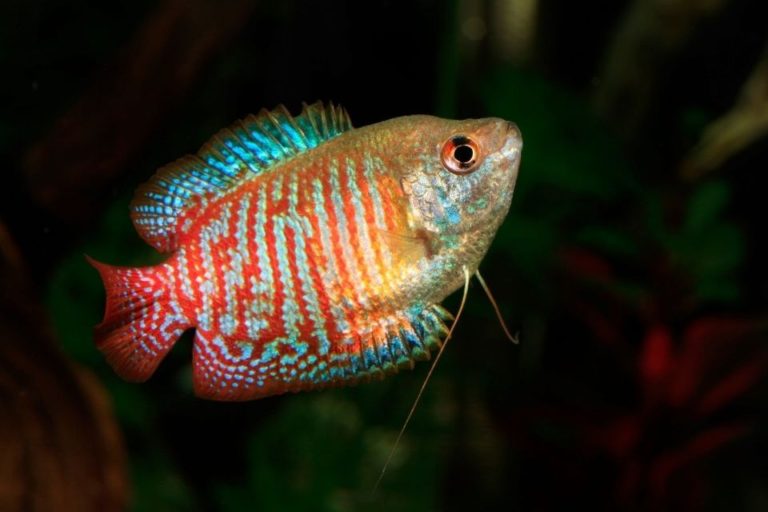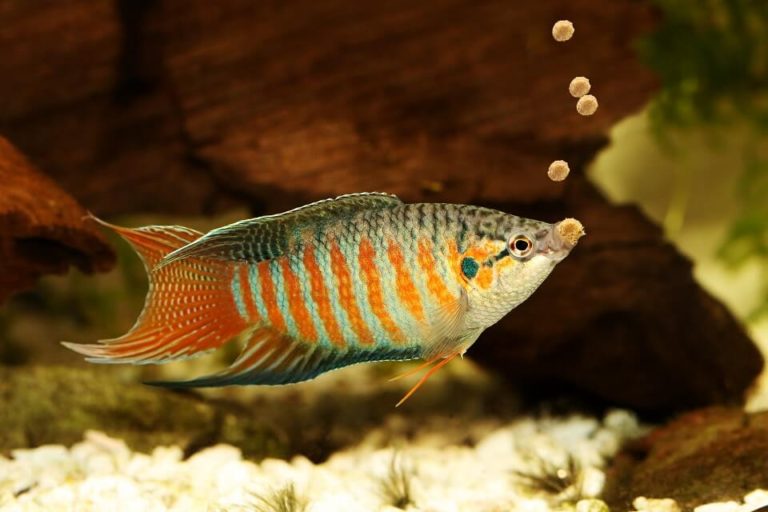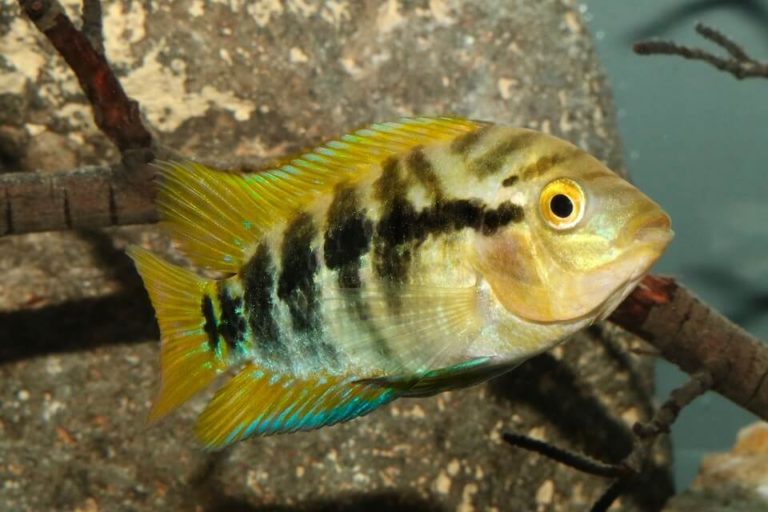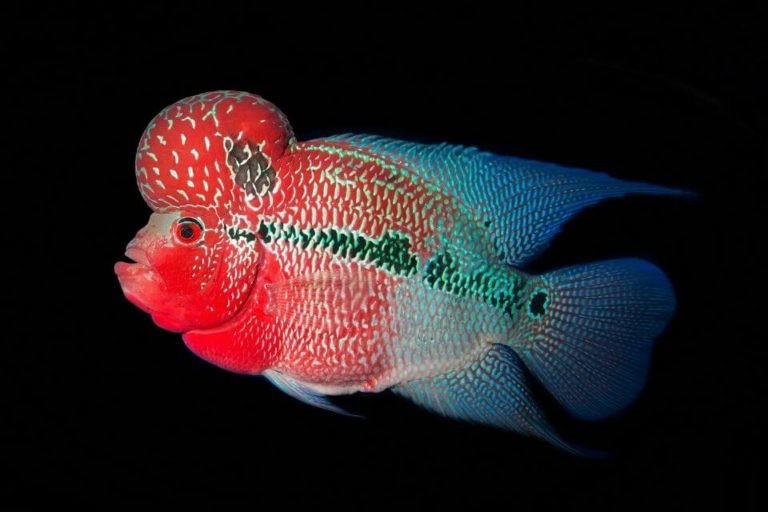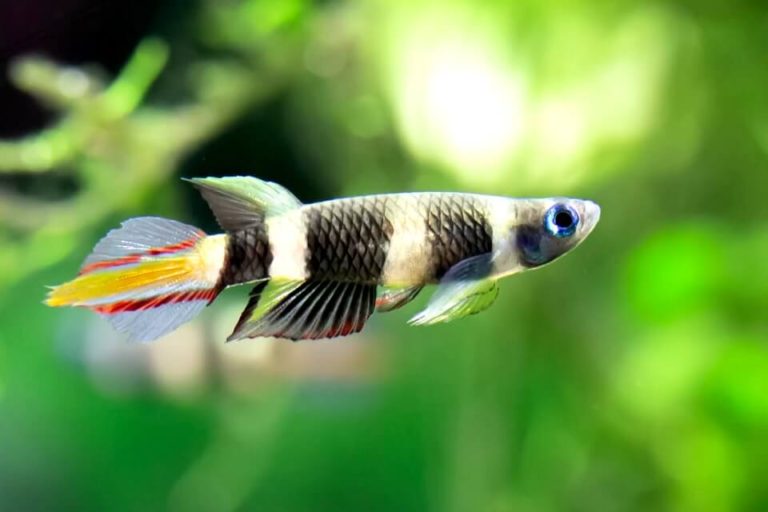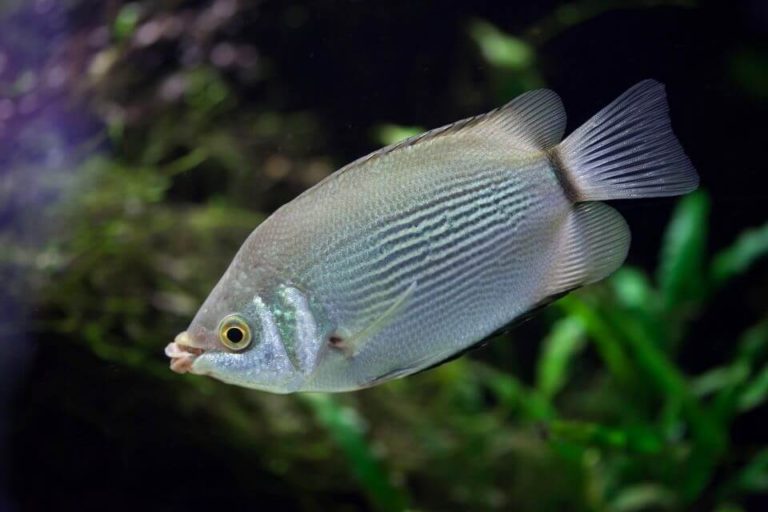Blood Parrot Cichlid Care – Tank Setup, Tankmates, Diet & Breeding Guide
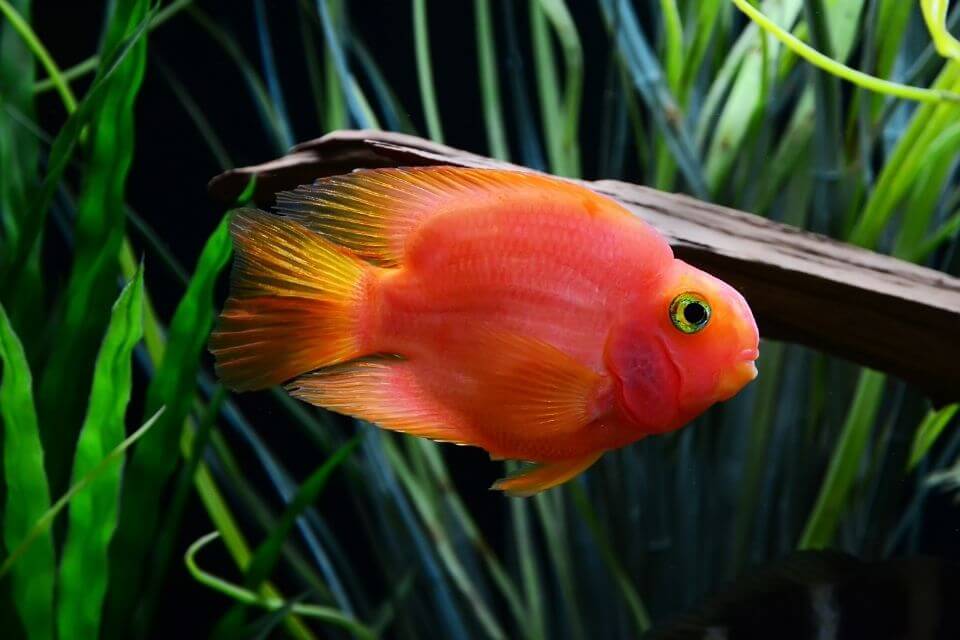
Are you a seasoned or passionate aquarist? Could it be that you have been seeking inspiration and appropriate guidance on the kinds of aquatic pets to keep?
Well, we are glad to introduce to you the Blood Parrot Cichlid in our care guide and conversations that follow.
| Quick Facts: | |
|---|---|
| Common Names : | Blood Parrot Cichlid Parrot Cichlid |
| Origin : | Man made in Taiwan |
| Family : | Cichlidae |
| Scientific Name : | Not yet defined |
| Care Level : | Medium |
| Temperament : | Semi-Aggressive |
| Social : | Territorial |
| Diet : | Omnivorous |
| Size (average) : | Up to 8 inches |
| Lifespan : | 10 to 15 years |
| Breeding : | Egg layer |
| Minimum Tank Size: | 30 gallons |
| Tank Environment : | Freshwater Sandy substrate Driftwood, Rocks Artificial plastic plants Floating plants |
| Temperature : | 76 - 80 °F (24 – 27 °C) |
| Water Hardness : | 6 - 18 dGH |
| Water pH Level : | 6.5 - 7.5 |
Species Overview
Blood Parrot Cichlid is one of the mid-sized breeds of the Cichlidae fish family. They are considered semi-aggressive freshwater fish species that considerably longer lifespan than other freshwater fish species.
This fish is a hybrid breed between the Gold Severum Cichlid and the Midas Cichlid. It was first bred in Taiwan in the year 1986. Not much is known about its past though it is generally hailed to be hardy and tolerant to diseases.
Mostly, it is bred for home and aesthetic needs and distributed worldwide lately.
Blood Parrot Cichlid Behavior & Temperament
How the fish species behave largely depends on the kind of environment it finds itself in. If in a crowded environment, these fish species tend to be very aggressive and largely defensive of its territory.
It just never seems to get along well with species of other kinds apart from it. If it is placed in a solitary place or in an area that is dominated by species of its kind, the species tends to be very calm and peaceful.
Generally, though, this species is semi-aggressive as it only displays its “wild side” when provoked or if it finds itself in the line of danger.
On the whole, also, these Cichlid species tend to enjoy their privacy considerably. For this reason, it spends much of its time hiding out from the open view of the people.
Occasionally, the species does swim around the middle of the water column not to mention digging for food at the base of the water tank.
Origin and Distribution
As hinted earlier, this species was first bred in Taiwan around 1986. It was a result of cross-breeding of the Redhead Cichlid (Vieja melanura) and the Midas Cichlid (Amphilophus citrinellus) species. Together, these give off pretty healthy and enduring fish.
It is not widely distributed though because the breeders have to purchase it from pet shops.
Blood Parrot Cichlid Size
The male fish does get to around 8 inches when fully grown and the males fish is generally larger than the females. the female Blood Parrot Cichlid size is around 6 to 7 inches long when fully grown.
From this sheer maximum size to be attained, the species has to be properly fed with a more balanced diet and on a consistent basis. At the same time, it has to be kept in a favorable environment with compatible tank mates.
Very fever aquarists have measured them up to 10 inches long when providing supreme care and high-quality tank environments.
Blood Parrot Cichlid Lifespan
Blood Parrot Cichlid does live to the ripe old age of 10 to 15 years. Then again, it all depends on the overall care and attention that it is accorded. Take great care of it, and watch it live longer than that.
Payless attention will reduce the life span and watch as it dies before its time. Providing optimal care will be the only option that you need to see thrive this fish in your tank.
Appearance and Colors
In its entirety, the species possesses a round body, has large fins, very large eyes, and a mouth that is shaped in the form of a beak.

It is very beautiful to behold with the naked eyes and is as such used for the matters of aesthetics and adorning the homes with the necessary beauty.
The exterior of the fish sparkles especially when hit with the light from the outside. It exudes some golden-brown hue that is really attractive to behold.
This color, though largely solid, is interrupted with patches of other colors, mainly white, and black. The interruption makes for really sparkling appearances.
Though rare, the exterior may also exhibit other colors like yellow and red. If you so wish, you may also dye the exterior to generate more color combinations. Nonetheless, this step greatly diminishes the overall lifespan of the fish species altogether.
Its external appearance tends to change as the fish species age. When young, the shape of the tails of the fish tends to resemble that of a heart. As they age, the shape of the tail changes and becomes more tapered and streamlined.
Given its hybrid nature, the species does exhibit some genetic deformities. These deformities do not compromise their beauty though.
In closing, the mouths of the species exhibit some interesting characteristics. They open vertically instead of horizontally. As such, they tend to resemble the beaks of the birds.
Some prominent nuchal humps and round heads wrap up the list of the appearance of the fish species.
Blood Parrot Cichlid Care
Needless to say, the fish species has to be well taken care of if there be any hope of the same thriving healthy and achieving their full potentials.
For you to take good care of these fish species and let them realize their full potential, you have to adhere to some care and maintenance regimes which we explain below:
– Blood Parrot Cichlid Tank Size
Around 30 gallons may be necessary to give the fish the room and the leeway to thrive to their full growth. If you must introduce additional fish in the tank, be sure to add a further 10 gallons of water per extra fish.
This again is necessary to give the fish the additional room it needs to thrive. For this reason, more specious tanks are recommended if affordable.
– Water Parameters
The quality of the water has to be top-notch. The water temperature, acidity levels, and water hardness have to be maintained at the following levels at all times.
- Water temperature: 76°F to 80°F
- Acidity: 6.5 to 7.5 pH
- Water hardness: 6 to 18 dGH
Please note that you must do regular water changes to your aquarium. Our recommendation is to change 25% of the water once a week to maintain the water quality of the tank.
On the other hand, it reduces the risks of infections in their space.
– Tank Setup
To set the tank up for the eventual keeping of the fish, you should place it atop a table and next to a source of natural light like the window. The tank ought to be made of clay pots, driftwood, and rocks.
The sandy substrate will be the best option for their tank bottom and avoid gravel as much as possible as the fish species does dig into them easily.
You ought to prioritize the mid and bottom-level tanks as they are most preferred by these kinds of fish species. The floating aquarium plants might work with these fish spaces best.
A water filtration system is somewhat required to help to clean the water that will save you time and maintain the water quality at the same time.
It is not a bad idea to cover the tank top with a weighted lid that will give you a peaceful mind, not to worry about escaping the fish from the tank.
– Suitable Plants
This species goes hand with a variety of other aquatic plants from which it derives its foods. Just about any other aquatic plant may do fine as long as it does not possess any poison.
Be sure hence to be selective and strict with the kinds of plants you introduce in the aquarium. Some recommended aquarium plants are:
Common Possible Diseases
Like any other species, this too is susceptible to certain sicknesses and diseases. Examples are:
Ich parasites
Your typical aquarium comprises many parasites that may harm the species. Of these, the ich parasites stand out. You counter them by raising the temperature of the water or by treating the same using copper.
This is to make the water safer and less prone to the disease.
Swim bladder disease
The swim bladder is an interior organ that is filled with air and contributes to the buoyancy of the fish.
This disease affects the organ and in doing so disparages the ability of the species to stay afloat at one water depth level. Administer the antibiotics to cure the fish of the ailment.
Red or inflamed gills
If your fish has red or inflamed gills, that could signify ammonia poisoning. In this case, the water in the tank appears murky and opaque.
In this sense, you have to change the water after which you have to administer the necessary medications. It is best to dedicate the task to a vet.
Bloody or torn fins
Bloody or torn fins are also caused by bacterial infections. The menace also arises when the fish is bruised by the external structures of the tank.
If you notice it, you should administer the necessary anti-bacterial infections and remove any imminent dangers in line of the fish at the time.
Pale scales
The paleness of the scales is largely caused by infections of the skin of the fish. In this sense, you ought to administer antibiotics as they have the power to counter the menace and put it under control.
Needless to say, you have to bring in a vet to help you out in this.

Blood Parrot Cichlid Feeding & Diet
Blood Parrot Cichlid is an omnivore meaning it feeds on both plants and animals at the same time. Since it spends much of its time in the middle and at the bottom of the tank, it prefers sinking foods.
The bloodworms and the live brine shrimps are by far their favorite meals. Other than this, freeze-dried foods, frozen, live, and flake diets are the most popular variants.
Additionally, the species loves foods that are rich in canthaxanthin and b-carotene as these help in maintaining their vibrant colors. Once fed, the species requires 16 to 24 hours to fully digest the feeds.
As pertains to the matters of feeding, you would rather feed the fish 2 to 3 times a day. When you administer the feeds, the fish make do with their beaks to pulverize the corals and reach out to the food at the base of the tank.
They then engulf the foods and ingest them into their systems.
If in the wild, the fish species chews the corals all day long. While at it, the species breaks down the food sources like algae (zooxanthellae), soft-bodied organisms (polyps), and the hard calcium carbonate skeleton.
This breakdown releases some energy that eventually powers the fish species.
Note: Take great care though that you do not overfeed the fish as that may pose some health problems.
Blood Parrot Tank Mates
Though this species is largely solitary, it can do well with a variety of plant and animal species. Some of the alternatives you may think of are:
- Bala Shark
- Yoyo Loach
- Honey Gourami
- Firemouth Cichlid
- Tiger Barb
- Sailfin Pleco
- Clown Pleco
- Dwarf Gourami
Gender Differences
When viewed outwardly, there is no significant difference between the male Blood Parrot Cichlid and the female fish as they largely look alike. The males are however larger than their female counterparts.
They are also slimmer and vibrantly colored than female Blood Parrot Cichlid. On the same note, the anal and the dorsal fins of the males are sharply pointed.
Blood Parrot Cichlid Breeding
It is interesting to note that the eggs of the females of this species are never fertilized by the males as is the norm with many fish species. That is because the males are largely infertile. Of course, the females do lay the eggs without the support or the input of the males.
Breeders hence use the hormones to trigger the egg-laying exercise. Females prefer to lay the eggs on smooth surfaces such as rocks. The ‘parents’ of the eggs protect it fiercely from predators and fungus.
In the unlikely event that the egg is infected with fungus, the parents eat the eggs. The eggs hatch after a matter of weeks to bring forth healthy and vibrant young Cichlids.
These have to be tended to well without exposing them to any germs or predators that may harm them as they grow. To ensure maximum survival, the eggs have to be cared for by a vet.
Is Blood Parrot Cichlid Aggressive?
NOT REALLY! The species is gentle, mild, and calm when in a solitary environment. It only displays aggressive tendencies when in contact with foreign species.
As a way forward hence, you have to keep it far away from the other aggressive fish species that are more likely to trigger adverse reactions.
Will My Cichlid Bite Me?
No, unless you provoke it. This Blood Parrot Fish is largely peaceful and less prone to develop hawkish tendencies. If you do make a mistake though of provoking it, you should expect to be bitten.
Certain sub-species like the African Cichlid are nonetheless very aggressive. Be very careful with the way you handle and interact with them hence.
Are Blood Parrot Fish Hardy?
YES, they are! This species hardly falls sick or endures infections of whichever kinds. In fact, the species has consistently survived many attacks and infections from agents like bacteria and viruses.
Because of this, you stand to spend less of your time, money, and effort in maintaining the fish in a healthy state.

Are Cichlids Good For Beginners?
YES, they are! A combination of hardiness, extreme tolerance to diseases and the fact that they require minimal care from you are some of the reasons that make this possible.
As a beginner, you are less likely to encounter too many hardships to start out and manage successful breeding.
How Many Blood Parrot Cichlids Can I Keep Together?
There is no standard quantity of the species you may keep at a time. As a general rule though, you have to keep the first one in the tank that measures 30 gallons.
If you must introduce an additional fish, you have to increase the capacity of the tank by a further 10 gallons per extra fish.
Where Blood Parrot Cichlid For Sale?
You may find Blood Parrot Cichlid for sale from the following locales:
Pet shops: Numerous pet shops do stock the fish and sell it to third parties. You have to check them out for a start. Be sure to visit the shop in person to remove all doubt before making a purchase.
Many unscrupulous traders have sold fake species to unsuspecting buyers.
Online auction sites: A variety of online auction sites also sell the species. You may also want to try them out. The beauty of these sites is that they give you the ability to compare the offerings of many dealers before making a purchase.
Then again they deliver the merchandise to the doorstep of the buyer.
How Big Do Blood Parrot Cichlids Get?
This species generally gets to 20 centimeters (8 inches) in size. The males are typically larger by virtue of measuring whereas the females measure an average of 6 to 7 inches.
This size is attained at the maximum age of about 10 to 15 years. It also requires constant healthy feeding to be able to attain.
Final Thoughts
You now have the inspiration you need to breed your Blood Parrot Cichlid, don’t you? Go ahead now and implement the insights faithfully.
If you are beginning, we urge you to keep only one fish at a time to prevent too many hassles and the dangers that potentially come about.


